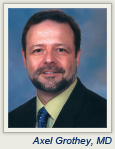 Individual oncologists will have to decide for themselves whether the results from the pooled analysis of cetuximab trials regarding G13D KRAS mutational status are ready for clinical application, according to Axel Grothey, MD, of the Mayo Clinic in Rochester, Minnesota.
Individual oncologists will have to decide for themselves whether the results from the pooled analysis of cetuximab trials regarding G13D KRAS mutational status are ready for clinical application, according to Axel Grothey, MD, of the Mayo Clinic in Rochester, Minnesota.
“We still need confirmatory data,” Dr. Grothey commented. In fact, a similar analysis of trials using the anti-EGFR antibody panitumumab (Vectibix) could soon be presented at an international meeting. In the meantime, “do I utilize [anti-EGFR therapy] in my clinical practice when I have a patient with G13D mutation? Yes, I do…if I see I am running out of options,” he said. “I’m not going to use EGFR antibodies as first-line therapies in these patients, but… [I might use them] in the last-line setting,” Dr. Grothey said.
Other Health-care Systems
 Meeting Chair Charles D. Blanke, MD, of the University of British Columbia in Canada, pointed out that the calculus might differ in other health-care systems.
Meeting Chair Charles D. Blanke, MD, of the University of British Columbia in Canada, pointed out that the calculus might differ in other health-care systems.
“Using anti-EGFR antibodies in G13D mutant disease seems like a reasonable thing to do if patients are paying for it or even if it is diffused among insurance companies and payers,” he elaborated. “In our case, we have to decide whether to fund it or not for the province of British Columbia. [Our protocols are] evidence-based, and we have a limited pie…. So the question is, should we fund it now? Is the evidence strong enough?”
“No, not yet,” Dr. Grothey replied, noting the some of the reported study’s analyses were based on small numbers of patients. “I’d like to see the data from the panitumumab trials.” (Editor’s note: Watch future issues of The ASCO Post for coverage of the panitumumab trials from the European Multidisciplinary Cancer Congress in Stockholm.)
Should that second anticipated analysis have the same results, the case would be sealed. “What I say right now is, I utilize [anti-EGFR therapy] as a salvage therapy option in select patients with G13D,” Dr. Grot concluded. “It’s not that common—about 8% of all patients who you might see and 18% of the KRAS mutant tumors.” ■

